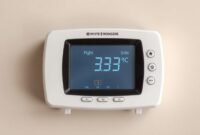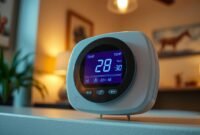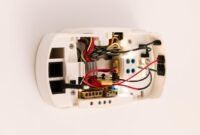Is your Honeywell thermostat flashing “Heat On” and driving you crazy? You’re not alone. This blinking signal can quickly turn into a heating nightmare at home. It’s time to act fast to keep your comfort and energy bills in check.
Thermostat troubleshooting might seem tough, but knowing the causes can save you a lot. It could be a simple battery issue or a bigger system problem. I’ll help you understand what’s behind your Honeywell thermostat’s flashing heat indicator.

Read also: Common Honeywell Thermostat Troubleshooting
Understanding Why Your Honeywell Thermostat Flashing Heat On
When your Honeywell thermostat flashes “Heat On,” it might worry you about your home’s temperature. I’ll explain what these lights mean and why they flash. This is a common alert for hvac maintenance.
The blinking lights aren’t always bad news. Most Honeywell thermostats use these lights to talk to you about system checks.
Common Causes of Flashing Display
- Power supply interruptions
- System startup protection mechanisms
- Potential furnace diagnostics issues
- Temperature regulation safeguards
Safety Features and Protection Mechanisms
Modern Honeywell thermostats have many safety features. These features keep your HVAC system safe from damage. They stop problems from quick cycles or electrical issues.
| Blinking Pattern | Potential Meaning | Recommended Action |
|---|---|---|
| Slow Blinking | Normal Startup Sequence | Wait 5 Minutes |
| Rapid Blinking | Potential System Error | Check Connections |
Normal vs Problematic Blinking Patterns
It’s important to know the difference between normal and problem blinking. A slow blink usually means everything is okay. But, if it blinks fast or keeps going, it might mean there’s a bigger issue.
Watch your thermostat closely. If it keeps blinking after five minutes, get help from a pro.
Five-Minute Delay Protection: What You Need to Know
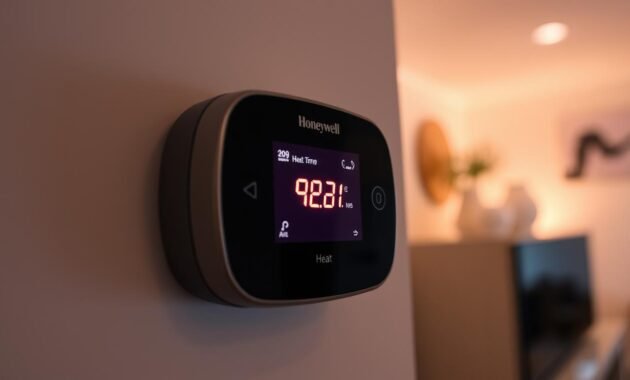
Smart home heating systems have a key feature: the five-minute delay protection. It’s vital for keeping your Honeywell thermostat running well. This safety feature stops damage by pausing after power cuts or system restarts.
Read also: Honeywell Thermostat Not Connecting to WiFi?
This delay is a safety step to protect your HVAC from short cycles. You might see a “wait” message or a flashing “heat on” light. It’s normal and important for a few reasons:
- It stops the system from cycling too fast.
- It keeps electrical parts safe.
- It reduces wear on heating equipment.
- It makes sure your smart home heating works best.
Knowing about thermostat error codes helps you understand these delays. When your Honeywell thermostat shows a delay, wait patiently. It’s working to keep your heating safe and efficient.
Here are common times when the five-minute delay kicks in:
- When there’s a sudden power outage.
- After an electrical system reset.
- When you manually change the system.
- As a protective measure against system stress.
Respecting this safety feature helps your HVAC last longer. It keeps your smart home heating at its best.
Power Supply Issues and Circuit Breaker Checks
Power problems can mess up your home’s heating system. It’s key to know how to find and fix these issues to keep your Honeywell thermostat working right.
Checking Electrical Connections
Take a close look at your thermostat’s electrical connections. If wires are loose or damaged, it can cause power issues and safety problems.
- Make sure all wire connections are tight
- Look for any wire damage
- Check if the wires are connected correctly
Resolving Power-Related Problems
Issues with the circuit breaker can stop your thermostat’s power. If the circuit breaker trips, it might be why your thermostat isn’t working.
- Find your home’s circuit breaker panel
- Find the breaker for your HVAC system
- Reset the breaker by turning it off and then on
Battery Replacement Guidelines
Replacing the thermostat battery is a simple but important task. Most Honeywell thermostats use standard AA or AAA alkaline batteries.
| Battery Type | Replacement Frequency | Recommended Action |
|---|---|---|
| AA Alkaline | Every 12-18 months | Replace with fresh batteries |
| AAA Alkaline | Every 12-18 months | Avoid using rechargeable batteries |
When you replace the thermostat battery, make sure to use the right type. The wrong batteries can cause problems or even make the system stop working.
Furnace Lockout Mode and Safety Mechanisms
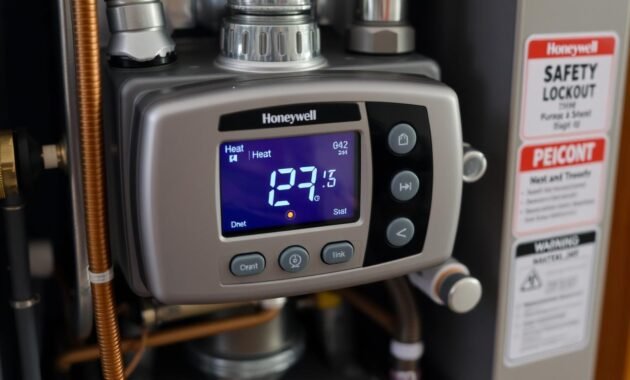
When your heating system faces safety risks, Honeywell support has a key feature: furnace lockout mode. This safety feature stops your furnace from running when it’s not safe. It keeps your home safe.
Furnace lockout can happen for a few reasons:
- Multiple unsuccessful startup attempts
- Persistent system cycling
- Potential overheating risks
- Electrical connection problems
Most furnaces today have advanced safety systems. They let you try starting twice before locking out. If it locks out, your thermostat will show a warning. This tells you there might be a problem.
Lockout modes are mainly two types:
- Soft Lockout: Temporary protection allowing system reset
- Hard Lockout: Requires manual intervention and professional assessment
If your furnace goes into hard lockout, you might need to reset it manually. Usually, this means turning off power for about 20 seconds and then starting it again. Regular maintenance can help avoid lockout problems.
Troubleshooting External Heating System Problems
When your Honeywell thermostat starts flashing, it could signal deeper issues with your external heating system. Understanding these problems can help you diagnose and potentially resolve heating challenges quickly.
Inspecting the Heat Pump
A broken sensor in your heat pump can trigger multiple warning signs. I recommend carefully examining the following components:
- Check refrigerant levels for possible leaks
- Inspect compressor functionality
- Verify electrical connections are secure
- Look for visible damage or wear
Checking Furnace Components
When the thermostat flashes wait 5 minutes, it might indicate underlying furnace problems. Critical areas to investigate include:
- Ensure furnace door is completely closed
- Examine air filter for excessive dirt
- Verify blower motor operation
- Check pilot light or electronic ignition
Identifying System Error Codes
Modern Honeywell thermostats provide diagnostic codes to help pinpoint specific issues. Here’s a quick reference for common error indicators:
| Error Code | Potential Problem | Recommended Action |
|---|---|---|
| E1 | Sensor Malfunction | Check wiring connections |
| E2 | Communication Error | Reset thermostat |
| E3 | Power Supply Issue | Inspect circuit breaker |
If these troubleshooting steps don’t resolve the issue, it may be time to consult a professional HVAC technician. They can provide a detailed system diagnosis.
Proper Thermostat Settings and Configuration
Setting up your Honeywell thermostat right is key for the best heating. Many people face thermostat flashing problems because of wrong settings. I’ll show you how to make sure your thermostat works great.
First, check your thermostat’s basic settings. Make sure it’s in “Heat” mode and the temperature is 3-5 degrees above the room’s current temperature. This simple step can fix many heating issues.
- Check system mode (Heat/Cool)
- Verify temperature settings
- Confirm system compatibility
- Inspect wiring connections
Studies show that 15% of heating problems come from thermostat wiring issues. It’s important to check your connections well and make sure they fit your heating system. About 4 out of 10 heating problems come from setting the system type wrong.
If your Honeywell thermostat keeps flashing, try a system reset. Turn it off, wait a few minutes, then turn it back on. This can fix small setup problems and make it work right again.
- Disconnect power for 2-3 minutes
- Reconnect and restart
- Verify system response
For complex systems like dual-fuel, getting help from a pro is a good idea. About 8% of heating setups need expert help to work best.
Essential Maintenance Steps for Prevention
Keeping your HVAC system in top shape needs regular care. Regular maintenance stops many temperature problems before they start. A few simple steps can make your heating and cooling last longer and work better.
- Inspect air filters monthly and replace every 90 days
- Clean thermostat sensors and surrounding areas
- Check electrical connections periodically
- Ensure proper ventilation around HVAC equipment
Regular Filter Maintenance
Air filters are key to your system’s efficiency. Dirty filters block airflow, making your HVAC work harder. This can lead to temperature problems. I suggest checking your filter monthly and replacing it every three months. If you have pets or live in a dusty area, you might need to change it more often.
System Cleaning Guidelines
Dust and debris can hurt your HVAC’s performance. Clean around vents and check the outdoor unit for leaves or debris. Also, gently wipe your thermostat with a soft, dry cloth. These steps help avoid sensor problems and keep your temperature readings accurate.
Read also: Easy How to Fix and Repair Navien Flow Sensor Problems
Spending just a few minutes each month on maintenance can save you money. It also keeps your home comfortable all year.
When to Contact a Professional HVAC Technician
DIY repairs can only go so far. I suggest trying simple fixes first. But, some problems need the help of a pro.
Knowing when to call a pro can save you time and money. It also prevents damage to your system. Here are signs you need an expert:
- Persistent thermostat blinking after multiple reset attempts
- Unusual sounds or burning smells from your heating system
- Inconsistent home temperature despite thermostat settings
- Visible electrical or wiring complications
- Recurring system error codes
Professional HVAC techs have tools to find complex issues. They can spot problems that DIY fixes can’t.
- Complex electrical system malfunctions
- Sensor and circuit board problems
- Advanced heating system component failures
- Intricate wiring configurations
If your heating system keeps having issues, call a certified HVAC technician. They ensure your system works well and lasts longer.
Conclusion
Figuring out why your Honeywell thermostat flashes “Heat On” is easier than you think. By doing some basic troubleshooting, most problems can be fixed. It’s all about being proactive and knowing when something’s not right.
A blinking “Heat On” on your Honeywell thermostat usually means it’s protecting itself. It might be waiting five minutes to avoid stress or warning you about electrical or mechanical issues. Knowing what these signals mean helps you act fast. Regular maintenance and checking connections can also prevent many issues.
When DIY efforts don’t work, calling a professional HVAC technician is a smart move. They can help you fix your heating system efficiently. A bit of knowledge and care can save you time, money, and prevent damage in the future.
